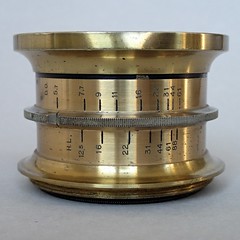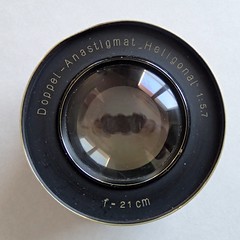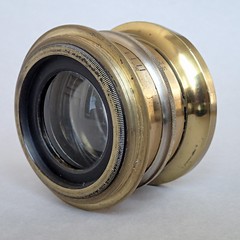Difference between revisions of "Heligonal"
m (Corrected heading) |
m (Updated LPA link; put margin on top photo) |
||
| (4 intermediate revisions by 2 users not shown) | |||
| Line 1: | Line 1: | ||
| − | + | <div class="floatright plainlinks" style="margin:0px 0px 20px 20px";> | |
{{Flickr image | {{Flickr image | ||
| image_source= http://www.flickr.com/photos/heritagefutures/12500375985/in/pool-camerawiki | | image_source= http://www.flickr.com/photos/heritagefutures/12500375985/in/pool-camerawiki | ||
| Line 8: | Line 8: | ||
|image_rights= with permission | |image_rights= with permission | ||
}} | }} | ||
| + | </div> | ||
| + | The '''Heligonal''' is an asymmetrical Double-Anastigmat variant with a Doublet front and Quadruplet rear group,<ref>All lenses are kitted.</ref> produced by G. [[Rodenstock]] in München (Germany). The lens can be used both as a Double-Anastigmat and, with the removal of the back lens group, as a simple [[Anastigmat]]; the lens barrel has aperture markings for both options. Unusually, the lens has a 13-leaved [[Diaphragm | diaphragm]].<ref>Diaphragm shown in this [http://www.flickr.com/photos/heritagefutures/12500501203/ image] (Dirk HR Spennemann via Flickr).</ref> | ||
| + | The Heligonal was introduced in 1905 and well received in the press of the day as lens that was sharp across the entire image<ref> Johnson, George Lindsay (1909) <i>Photographic Optics and Colour Photography: Including the Camera, Kinematograph, Optical Lantern, and the Theory and Practice of Image Formation.</i> New York: D. Van Nostrand Company. P. 128</ref>, even though later scholars were much more critical of the asymmetrical design.<ref>"Occasionally, for some reason, a designer will try the effect of combining two dissimilar cemented components about a central stop. It is hard to see the virtue of such an arrangement, except perhaps as an economy measure." ([[Rudolf Kingslake |Kingslake, Rudolf]] [1989] A history of the photographic lens. London: Academic Press, p. 102).</ref> While still advertised in 1910 in Sweden<ref name="Forsner">Forsner's Fotografiska Magasin. Priskurant I 1910-11. Stockholm Örebro. p. 107 [http://www.largeformatphotography.info/forum/showthread.php?58711-What-do-you-need-from-a-1910-European-Catalogue&p=632650&viewfull=1#post632650 page image] reproduced in post in www.largeformatphotography.info.</ref> and in 1911 in Estonia,<ref name="Parikas"> Parikas, Johannes Ja Peter (1911) <i>Fotografia Õperaamat</i>. Tallin [https://www.digar.ee/arhiiv/et/kollektsioonid/20779 online copy, pdf]. Advert in catalogue on p ii and in text p. 19 Fig 17).</ref> the Heligonal is not listed in the Rodenstock 1912 export catalogue to the USA.<ref>[https://www.cameraeccentric.com/static/img/pdfs/rodenstock_2.pdf G. Rodenstock Lenses of Quality Catalog 1912 (pdf)] via www.cameraeccentric.com.</ref> It would appear that in Rodenstock's line-up it was quickly replaced by the symmetrically arranged [[Rodenstock | Eurynar]] (which also sold at a much cheaper price) and that the Heligonal was apparently was no longer made by 1926<ref>M. Wilkinson and C. Glanfield (<i>A lens collector's vademecum,</i> 2001) Entry on Rodenstock.</ref> (if not already terminated earlier). The Heligonal seems to have had a limited sales market,<ref>Serial number range from s/n 6328 (a 48cm) to s/n 27648 (a 30cm).—s/n 51013 (a 30cm) is probably a typesetting error in the auction listing.—All [[Rodenstock serial numbers]] of the Heligonal are before 1910.</ref> even though it had been offered in a wide range of focal lengths (12cm to 48cm, see below). In consequence, today, the pre World War I versions are very uncommon units on the collector's market. | ||
| − | |||
| − | |||
| − | |||
| − | |||
| − | |||
| − | |||
{{Flickr image | {{Flickr image | ||
| image_source= http://www.flickr.com/photos/heritagefutures/12417410525/in/pool-camerawiki | | image_source= http://www.flickr.com/photos/heritagefutures/12417410525/in/pool-camerawiki | ||
| Line 25: | Line 22: | ||
|image_rights= with permission | |image_rights= with permission | ||
}} | }} | ||
| − | + | '''Doppel-Anastigmat-Heligonal''' <br>On record are these focal lengths: | |
| − | |||
*12cm f/5.4 barrel lens<ref>in [http://www.photohistory.at/kameras2.htm Lechner's Stereoskop-Reflexkamera] (ca. 1905) via www.photohistory.at;</ref> | *12cm f/5.4 barrel lens<ref>in [http://www.photohistory.at/kameras2.htm Lechner's Stereoskop-Reflexkamera] (ca. 1905) via www.photohistory.at;</ref> | ||
*15cm f/5.5 in shutter | *15cm f/5.5 in shutter | ||
| Line 32: | Line 28: | ||
*21cm f/5.7 barrel lens<ref>s/n 9547 (Photographica Collection Dirk HR Spennemann).</ref> | *21cm f/5.7 barrel lens<ref>s/n 9547 (Photographica Collection Dirk HR Spennemann).</ref> | ||
*24cm f/5.7 barrel lens<ref> | *24cm f/5.7 barrel lens<ref> | ||
| − | s/n 12614 [ | + | s/n 12614 [https://www.leitz-auction.com/en/Ernemann-Globus-G/AI-7-24673 in Ernemann Globus G] (at the seventh Westlicht auction); |
s/n 13897 (Seen in a Russian on-line auction May 2013).</ref> | s/n 13897 (Seen in a Russian on-line auction May 2013).</ref> | ||
*30cm f/5.9 barrel lens <ref>f/stops at: 5.9, 7.7, 9, 11, 18, 22, 31, 44, 61.— | *30cm f/5.9 barrel lens <ref>f/stops at: 5.9, 7.7, 9, 11, 18, 22, 31, 44, 61.— | ||
Latest revision as of 03:38, 6 February 2024
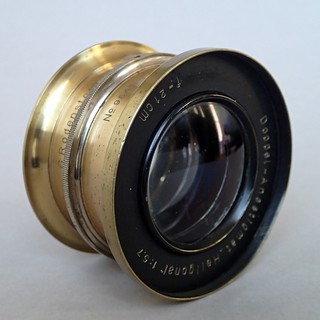
|
| Rodenstock Heligonal 21cm f/5.7 image by Dirk HR Spennemann (Image rights) |
The Heligonal is an asymmetrical Double-Anastigmat variant with a Doublet front and Quadruplet rear group,[1] produced by G. Rodenstock in München (Germany). The lens can be used both as a Double-Anastigmat and, with the removal of the back lens group, as a simple Anastigmat; the lens barrel has aperture markings for both options. Unusually, the lens has a 13-leaved diaphragm.[2]
The Heligonal was introduced in 1905 and well received in the press of the day as lens that was sharp across the entire image[3], even though later scholars were much more critical of the asymmetrical design.[4] While still advertised in 1910 in Sweden[5] and in 1911 in Estonia,[6] the Heligonal is not listed in the Rodenstock 1912 export catalogue to the USA.[7] It would appear that in Rodenstock's line-up it was quickly replaced by the symmetrically arranged Eurynar (which also sold at a much cheaper price) and that the Heligonal was apparently was no longer made by 1926[8] (if not already terminated earlier). The Heligonal seems to have had a limited sales market,[9] even though it had been offered in a wide range of focal lengths (12cm to 48cm, see below). In consequence, today, the pre World War I versions are very uncommon units on the collector's market.
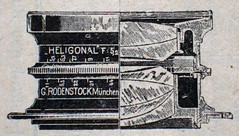
|
| Lens design and cross-section[5] image by Dirk HR Spennemann (Image rights) |
Doppel-Anastigmat-Heligonal
On record are these focal lengths:
- 12cm f/5.4 barrel lens[10]
- 15cm f/5.5 in shutter
- 15cm f/5.5 in shutter[11]
- 21cm f/5.7 barrel lens[12]
- 24cm f/5.7 barrel lens[13]
- 30cm f/5.9 barrel lens [14]
- 48cm f/6.3 barrel lens[15]
Apochromat Heligonal
- 60cm barrel lens [16]
|
|
| ||||||
|
Rodenstock Heligonal 21cm f/5.7 | ||||||||
Links
Notes
- ↑ All lenses are kitted.
- ↑ Diaphragm shown in this image (Dirk HR Spennemann via Flickr).
- ↑ Johnson, George Lindsay (1909) Photographic Optics and Colour Photography: Including the Camera, Kinematograph, Optical Lantern, and the Theory and Practice of Image Formation. New York: D. Van Nostrand Company. P. 128
- ↑ "Occasionally, for some reason, a designer will try the effect of combining two dissimilar cemented components about a central stop. It is hard to see the virtue of such an arrangement, except perhaps as an economy measure." (Kingslake, Rudolf [1989] A history of the photographic lens. London: Academic Press, p. 102).
- ↑ 5.0 5.1 Forsner's Fotografiska Magasin. Priskurant I 1910-11. Stockholm Örebro. p. 107 page image reproduced in post in www.largeformatphotography.info.
- ↑ Parikas, Johannes Ja Peter (1911) Fotografia Õperaamat. Tallin online copy, pdf. Advert in catalogue on p ii and in text p. 19 Fig 17).
- ↑ G. Rodenstock Lenses of Quality Catalog 1912 (pdf) via www.cameraeccentric.com.
- ↑ M. Wilkinson and C. Glanfield (A lens collector's vademecum, 2001) Entry on Rodenstock.
- ↑ Serial number range from s/n 6328 (a 48cm) to s/n 27648 (a 30cm).—s/n 51013 (a 30cm) is probably a typesetting error in the auction listing.—All Rodenstock serial numbers of the Heligonal are before 1910.
- ↑ in Lechner's Stereoskop-Reflexkamera (ca. 1905) via www.photohistory.at;
- ↑ Apparecchio fotografico per cinetismi, a soffietto, a lastre G. Rodenstock via www.lombardiabeniculturali.it
- ↑ s/n 9547 (Photographica Collection Dirk HR Spennemann).
- ↑ s/n 12614 in Ernemann Globus G (at the seventh Westlicht auction); s/n 13897 (Seen in a Russian on-line auction May 2013).
- ↑ f/stops at: 5.9, 7.7, 9, 11, 18, 22, 31, 44, 61.— s/n 27648 (see in Chinese on-line auction June 2006; s/n 51013 on Kood 390 Studio Camera (Swedish auction archived via archive-ee.com.)
- ↑ f6.3 to f88; s/n 6328 worthpoint.com.
- ↑ Simon Kidd via flickr; XXX.
